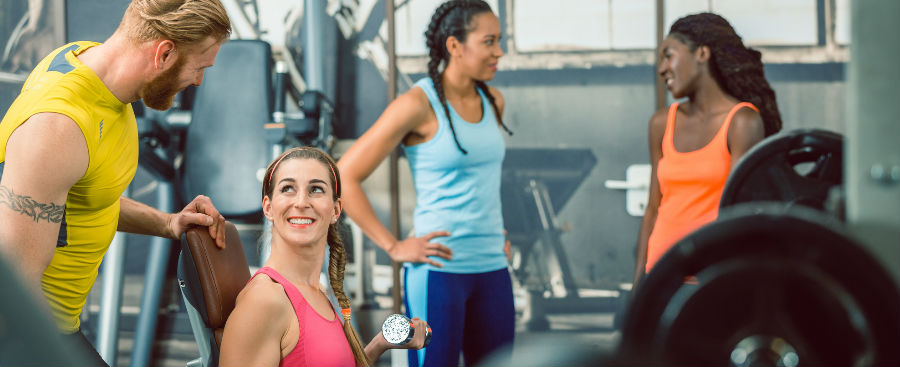
By Alissa Rogers, Special AFS Contributor
When it comes to your fitness business, the best (and sometimes most difficult) way to grow is by attracting new customers who aren’t your current target audience. This sounds daunting, but there are actually some easy ways you can broaden your client base while staying true to your brand.
What it really comes down to being more inclusive and mindful of different types of customers. We’ve identified some of these groups—and ways you can encourage them to come through your door.
Older Adults
Seniors love saving on more than just an early dinner. Consider offering a discount for people 65 and up, or partnering with the Silver Sneakers program. Once you get them in the door, you’ll want to look at modifying your current classes or programs (or adding new ones) to make sure they’re safe and inclusive for all ages and experience levels. Better yet, you can bring your brand to them by offering pop-up classes or walking groups with the local senior centers!
Parents
There’s likely no other group begging for some “me time” (and that probably needs it the most) as much as parents. To appeal to more people with family needs, offer express classes—30 to 45 minutes—or if you can, on-site childcare. You can also add pre and postnatal classes to your schedule, or even “parent and me” classes where they can bring their kids with them. (Nothing like starting them young on the routine of coming to your business, right?)
Students
This is a group that’s eager to learn…but not always to spend. To entice more students to your services, consider offering them a membership discount. You can also partner with local schools to promote your business on campus or teach a class at their rec center. This will not only get your name and reputation out there, but may even get them to visit your actual location, too.
Our Wellness Index found that 18–25 year-olds are most interested in fitness activities like kickboxing, CrossFit®, and swimming—so make sure you keep your offerings relevant and exciting to this group. And if you’re open to bringing them onto your team, implement a trade option: they get a free membership for working at your gym (cleaning, front desk, admin, etc.). If you want to read more about marketing to students, get this free guide.
The Newbies
Chances are, there’s a whole bunch of beginners in your community who are intimidated or don’t know where to start when it comes to fitness. To get yourself in front of them, start doing pop-up community classes or walking groups (the best low-intensity way to get people moving) with your business’s name on them. This will help them become more comfortable with the idea of coming into class.
Next, take a look at your class schedule. Do you have offerings that appeal to first timers? Are your instructors prepared to adjust if someone is new? You can even offer workshops on the types of classes you have that break down fitness basics. The most important thing here is to make it accessible and easy for someone who’s never done any type of exercise to feel welcome at your gym.
Chances are, there’s a whole bunch of beginners in your community who are intimidated or don’t know where to start when it comes to fitness. To get yourself in front of them, start doing pop-up community classes or walking groups with your business’s name on them.
The LGBTQIA+ Community
It goes a long way for a brand to be inviting to everyone. More businesses are offering gender-neutral bathrooms and changing rooms—and you can do the same without tearing down your existing structures. Whether it’s a stall or curtains, see if you can add some partitions to create privacy when it’s desired.
Something else that makes a difference for your LGBTQIA+ clients is to encourage your staff to use inclusive language and cues. Have thoughtful conservations around using words like “we, us, you” versus gender-explicit terms—it’s a tiny change but can have a huge impact on how people feel during your classes. Not sure where to start? Reach out to members, staff, or organizations who are a part of this community to ask for their input.
Multicultural Groups
More than 20% of Americans are bilingual. Make your facility a little more welcoming by hiring some instructors who speak multiple languages, and offer collateral and class materials in something other than English. Music is a huge part of your business’s vibe—think about the music you play and add some tracks in other languages to appeal to everyone.
Differently-abled People
Fitness isn’t just for one type of body or level of ability. Invite everyone into your facility, and make sure they can actually participate with elements like wheelchair-friendly entrances, assistive equipment, and various weight sets. Your staff can get certified in corrective movement, or at the very least have an extra instructor on hand to help during classes or sessions. To appeal to people with chronic ailments, create programs specifically for them to follow. Not everyone can drive, so you may want to keep in mind public transportation scheduling and adjust accordingly so everyone can make it.
Once you’ve made these adjustments to welcome more types of people into your business, the right marketing and retention strategies can make sure they come back again. It’s not about just “talking the talk”—make it consistent through every aspect of your brand. Use diverse images in your marketing materials to accurately reflect what your business stands for and choose relevant channels for whichever audience you’re targeting. (For example, Facebook is effective for older folks, while students and young adults prefer Instagram.)
Whether it’s in your facility or out in your community, host and promote events to show people that you can help them achieve their best self. All these potential customers have different needs, and meeting them will help you have a bigger community impact and grow your business.
To read more about expanding the customer base at your fitness business, check out our resources.
Alissa Rogers is a Senior Marketing Copywriter at MINDBODY, the leading software for wellness businesses. She works on everything from ad campaigns and direct mail to events and sales enablement. Based in San Diego, California, she’s also a certified yoga instructor who lives for happy hours.


Join the Conversation!